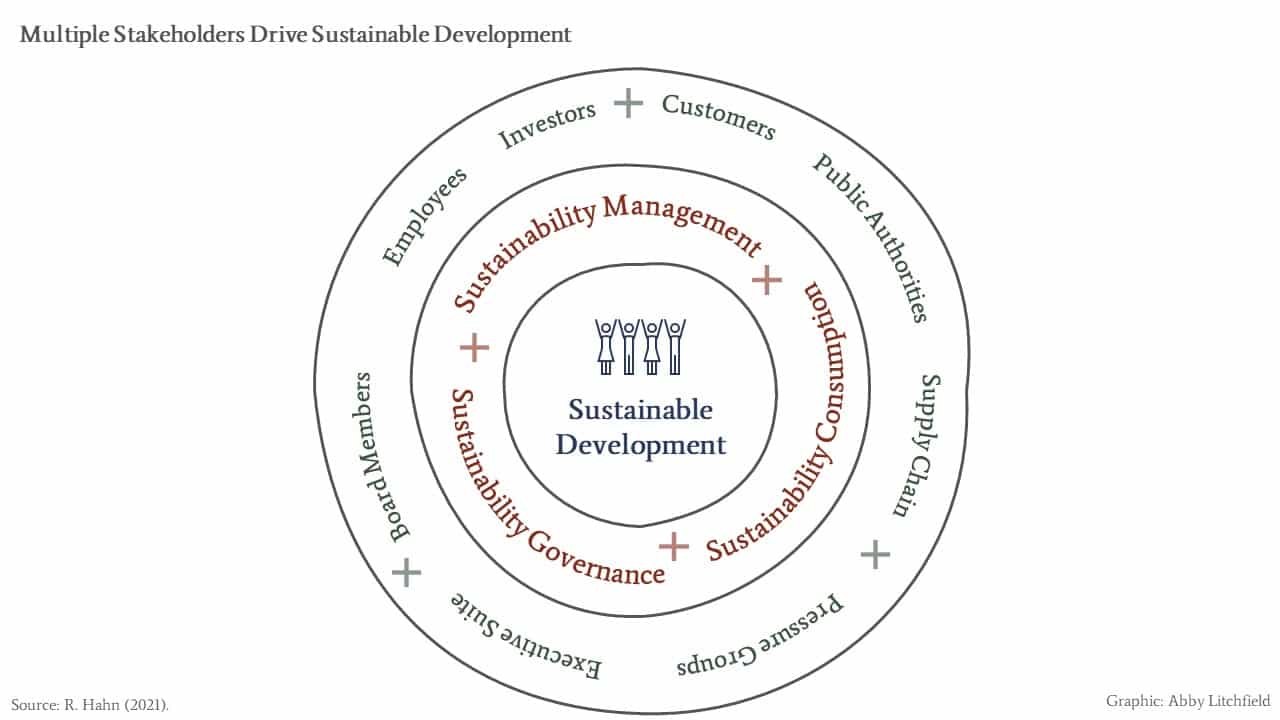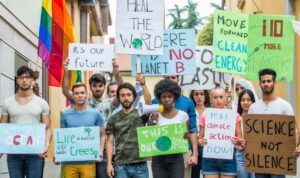Sustainability management education involves complexity, specific tools, and a vision for the future.
Rüdiger Hahn is the Henkel-Endowed Chair of Sustainability Management at the Heinrich-Heine-University Düsseldorf
I have two children, both kindergarten age. When they approach my wife or me with questions on sustainability (“Dad, why is there so much garbage lying around?” or “Mom, why don’t we do something to help the polar bears?”), I always think that we could go so much further with sustainability if everybody would do their part.
But sustainability and sustainability management are complex and even if humankind generally knows what we need to do, we are still far away from actually doing it.
After more than 15 years of research and teaching, and after creating a textbook on sustainability management, I want to share what I’ve learned. There are three main themes:
- Scientific information alone won’t lead to action
- Students need to grapple with “wicked” problems
- Future business leaders need concrete tools and a realistic perspective
Scientific knowledge of sustainability is not enough for action
As educators, it’s easy to think that knowledge changes action. But facts about sustainability, on their own, usually won’t drive behaviour change.
Take the example of climate change: Already in 1896 (!), Svante Arrhenius discussed in a scientific article “the influence of carbon acid in the air upon the temperature on the ground.” And in 1912, Francis Molena even more vividly argued, again in a scientific article, that the carbon dioxide emitted when burning coal “tends to make the air a more effective blanket for the earth and to raise its temperature.”
More than 100 years later, there is vast scientific consensus on human-caused climate change. Yet at UN Climate Change Conferences, responsibilities and commitments remain vague; many agree that valuable years have been lost in combating climate change.
The climate change example and many others show that action requires more than knowledge of the physical science. In my teaching, I’ve found that we need to communicate sustainability as a highly complex societal issue, involving many different actors and perspectives; action needs to be framed in those terms. We also need to provide students with concrete tools to guide action, and a realistic perspective on what’s possible.
Use multiple perspectives to help students understand and embrace “wicked problems”
Sustainability issues are often so-called “wicked problems,” with multiple causes and no “right” answer. In particular, they can’t be resolved by the isolated actions of one group. For example: Regulators and politicians are usually restricted by national borders, consumers often do not know or do not care about the consequences of their purchases, and companies feel market pressure if environmental regulations do not pay off financially.
As a result, there is almost always “somebody else” who has to (not) do something to improve sustainability, and this is often the biggest excuse not to do anything. When I begin my lectures on sustainability management by illustrating the status quo of sustainable development and then ask for suggested improvements, someone always claims that “without the actions of customers/ investors/ governments … sustainability management is doomed to fail.”
This is often correct! At the same time, however, it is not helpful to always expect others to take the first step. I often call this excuse “kindergarten logic” (“If he does not stop teasing me, I won’t stop teasing him”). Future managers need to embrace, not ignore, the reality of the many actors involved to be able to improve their company’s sustainability performance.
In my courses, therefore, I try to offer multiple perspectives of sustainability and sustainability management. I approach sustainability management from a stakeholder perspective, with a focus on companies’ relationships with the many actors that shape sustainable outcomes. How do companies interact as central and often powerful players in these dynamics?
The graphic below shows my way of presenting these relationships to students.
This approach lets students understand the importance of multiple actors, and begin to think about how they might engage with them.
I also emphasize the conflicting perspectives within each stakeholder group. Some customers might pay a price premium for sustainable products while others don’t. Some employees might prefer a company that addresses societal issues while others don’t care. This nuance produces hurdles and problems for sustainability management but also allies and opportunities.
Provide concrete tools and a realistic perspective
Once students have a holistic perspective, I believe that we need to equip them with specific guidance and a critical yet optimistic mindset. Practical tools can enable concrete action. And students need to be aware of the challenges but also have faith that they and their companies can advance sustainable development.
Concrete tools and resources
I try to be as concrete as possible in my teaching about the wide range of sustainability management tools and approaches to which companies have access. I focus on functional perspectives (e.g., marketing, supply chain management, accounting) and their related approaches and tools (e.g., product service systems, supplier audits, life cycle sustainability analysis).
I always emphasize that tools’ usefulness depends on specific company characteristics (e.g., industry or size) and other circumstances (e.g., country of operation). Tools also shouldn’t be viewed in isolation, as successful sustainability management is always interdisciplinary, requiring efforts throughout a company and often even beyond.
Using best practice examples from around the world illustrates the variety of sustainability management. For example, students in Europe or the US are often surprised to learn that mobile money applications first reached mass markets in Africa.
A critical yet optimistic perspective
It’s important to also identify failures of such approaches and tools as well to illustrate the many hurdles in sustainability management and illustrate ways to overcome them. This includes speaking to business’s “dark side” and providing “worst practice examples,” not least to build a teacher’s credibility as informed and independent. There are probably as many black sheep in the business world as there are visionary sustainability leaders. I ask students to share their own worst (and best) practice examples, often sparking discussion.
Combining conceptual knowledge of tools and approaches with practical examples of company reality can be another way to help overcome the aforementioned kindergarten logic, where people look to others to act. Instead, students, practitioners, and even teachers can then build upon the best aspect of kindergarteners. This quality is the vigorous optimism children harness to encourage others to be more sustainable human beings.
Sustainability Management – The textbook!
If you want to know more about my approach to teaching sustainability management, have a look at my textbook.
With this textbook, I try to enable others to follow my approach sketched above. I support instructors in introducing sustainability management tools and approaches from essential management domains such as marketing, accounting, supply chain management, strategy, or innovation management while employing an extensive stakeholder perspective.
Various features enrich the book with examples of thought leaders in sustainability (“Faces of Sustainability”); examples on sustainability and unsustainability in business practice globally (“Sustainability in Business”); practical challenges, ideas, and concepts of sustainability broadly (“Sustainability in Society”), and key research articles on sustainability management (“Sustainability in Research”).



Add a Comment
This site uses User Verification plugin to reduce spam. See how your comment data is processed.This site uses User Verification plugin to reduce spam. See how your comment data is processed.